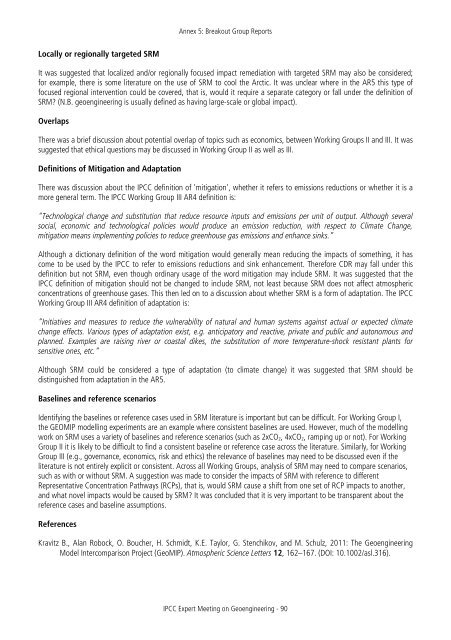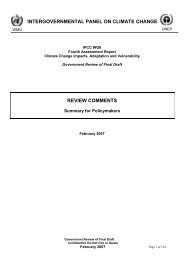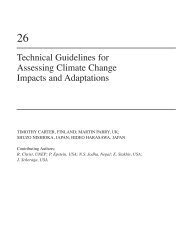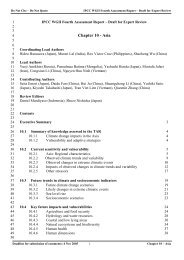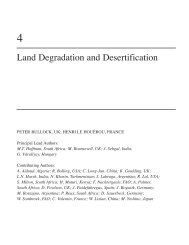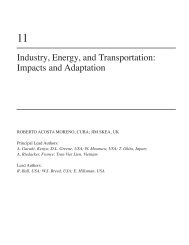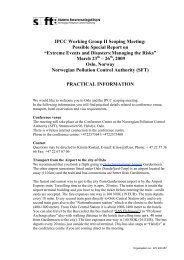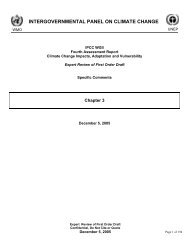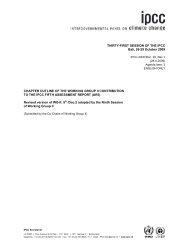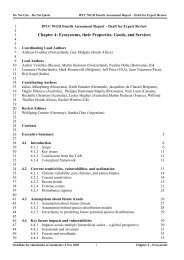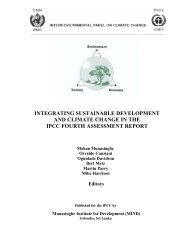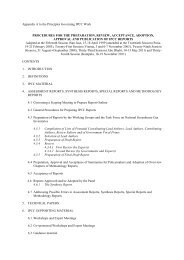IPCC Expert Meeting on Geoengineering
IPCC Expert Meeting on Geoengineering
IPCC Expert Meeting on Geoengineering
You also want an ePaper? Increase the reach of your titles
YUMPU automatically turns print PDFs into web optimized ePapers that Google loves.
Annex 5: Breakout Group Reports<br />
Locally or regi<strong>on</strong>ally targeted SRM<br />
It was suggested that localized and/or regi<strong>on</strong>ally focused impact remediati<strong>on</strong> with targeted SRM may also be c<strong>on</strong>sidered;<br />
for example, there is some literature <strong>on</strong> the use of SRM to cool the Arctic. It was unclear where in the AR5 this type of<br />
focused regi<strong>on</strong>al interventi<strong>on</strong> could be covered, that is, would it require a separate category or fall under the definiti<strong>on</strong> of<br />
SRM? (N.B. geoengineering is usually defined as having large-scale or global impact).<br />
Overlaps<br />
There was a brief discussi<strong>on</strong> about potential overlap of topics such as ec<strong>on</strong>omics, between Working Groups II and III. It was<br />
suggested that ethical questi<strong>on</strong>s may be discussed in Working Group II as well as III.<br />
Definiti<strong>on</strong>s of Mitigati<strong>on</strong> and Adaptati<strong>on</strong><br />
There was discussi<strong>on</strong> about the <str<strong>on</strong>g>IPCC</str<strong>on</strong>g> definiti<strong>on</strong> of 'mitigati<strong>on</strong>', whether it refers to emissi<strong>on</strong>s reducti<strong>on</strong>s or whether it is a<br />
more general term. The <str<strong>on</strong>g>IPCC</str<strong>on</strong>g> Working Group III AR4 definiti<strong>on</strong> is:<br />
“Technological change and substituti<strong>on</strong> that reduce resource inputs and emissi<strong>on</strong>s per unit of output. Although several<br />
social, ec<strong>on</strong>omic and technological policies would produce an emissi<strong>on</strong> reducti<strong>on</strong>, with respect to Climate Change,<br />
mitigati<strong>on</strong> means implementing policies to reduce greenhouse gas emissi<strong>on</strong>s and enhance sinks.”<br />
Although a dicti<strong>on</strong>ary definiti<strong>on</strong> of the word mitigati<strong>on</strong> would generally mean reducing the impacts of something, it has<br />
come to be used by the <str<strong>on</strong>g>IPCC</str<strong>on</strong>g> to refer to emissi<strong>on</strong>s reducti<strong>on</strong>s and sink enhancement. Therefore CDR may fall under this<br />
definiti<strong>on</strong> but not SRM, even though ordinary usage of the word mitigati<strong>on</strong> may include SRM. It was suggested that the<br />
<str<strong>on</strong>g>IPCC</str<strong>on</strong>g> definiti<strong>on</strong> of mitigati<strong>on</strong> should not be changed to include SRM, not least because SRM does not affect atmospheric<br />
c<strong>on</strong>centrati<strong>on</strong>s of greenhouse gases. This then led <strong>on</strong> to a discussi<strong>on</strong> about whether SRM is a form of adaptati<strong>on</strong>. The <str<strong>on</strong>g>IPCC</str<strong>on</strong>g><br />
Working Group III AR4 definiti<strong>on</strong> of adaptati<strong>on</strong> is:<br />
“Initiatives and measures to reduce the vulnerability of natural and human systems against actual or expected climate<br />
change effects. Various types of adaptati<strong>on</strong> exist, e.g. anticipatory and reactive, private and public and aut<strong>on</strong>omous and<br />
planned. Examples are raising river or coastal dikes, the substituti<strong>on</strong> of more temperature-shock resistant plants for<br />
sensitive <strong>on</strong>es, etc.“<br />
Although SRM could be c<strong>on</strong>sidered a type of adaptati<strong>on</strong> (to climate change) it was suggested that SRM should be<br />
distinguished from adaptati<strong>on</strong> in the AR5.<br />
Baselines and reference scenarios<br />
Identifying the baselines or reference cases used in SRM literature is important but can be difficult. For Working Group I,<br />
the GEOMIP modelling experiments are an example where c<strong>on</strong>sistent baselines are used. However, much of the modelling<br />
work <strong>on</strong> SRM uses a variety of baselines and reference scenarios (such as 2xCO 2, 4xCO 2, ramping up or not). For Working<br />
Group II it is likely to be difficult to find a c<strong>on</strong>sistent baseline or reference case across the literature. Similarly, for Working<br />
Group III (e.g., governance, ec<strong>on</strong>omics, risk and ethics) the relevance of baselines may need to be discussed even if the<br />
literature is not entirely explicit or c<strong>on</strong>sistent. Across all Working Groups, analysis of SRM may need to compare scenarios,<br />
such as with or without SRM. A suggesti<strong>on</strong> was made to c<strong>on</strong>sider the impacts of SRM with reference to different<br />
Representative C<strong>on</strong>centrati<strong>on</strong> Pathways (RCPs), that is, would SRM cause a shift from <strong>on</strong>e set of RCP impacts to another,<br />
and what novel impacts would be caused by SRM? It was c<strong>on</strong>cluded that it is very important to be transparent about the<br />
reference cases and baseline assumpti<strong>on</strong>s.<br />
References<br />
Kravitz B., Alan Robock, O. Boucher, H. Schmidt, K.E. Taylor, G. Stenchikov, and M. Schulz, 2011: The <strong>Geoengineering</strong><br />
Model Intercomparis<strong>on</strong> Project (GeoMIP). Atmospheric Science Letters 12, 162–167. (DOI: 10.1002/asl.316).<br />
<str<strong>on</strong>g>IPCC</str<strong>on</strong>g> <str<strong>on</strong>g>Expert</str<strong>on</strong>g> <str<strong>on</strong>g>Meeting</str<strong>on</strong>g> <strong>on</strong> <strong>Geoengineering</strong> - 90


